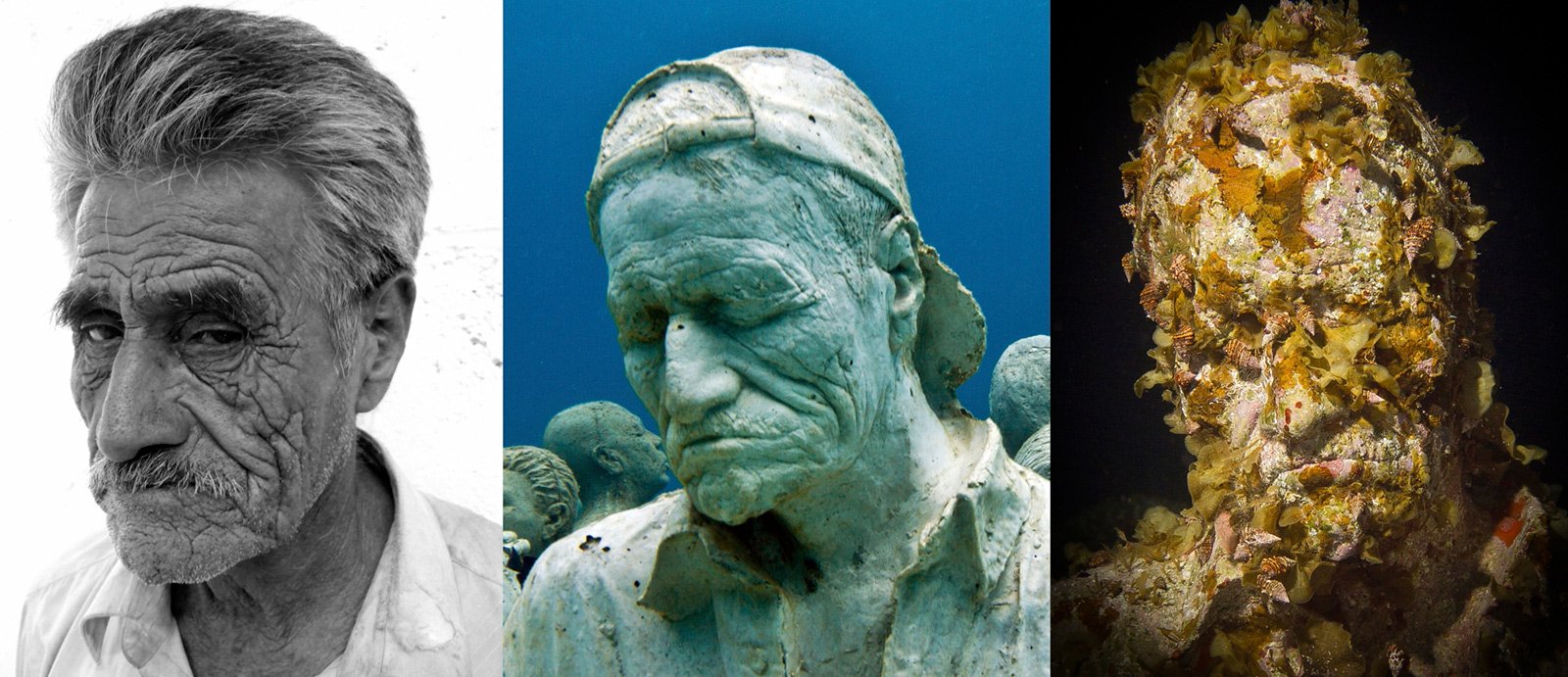How Art is Shaping Coral Reef Conservation
Written by Carleigh Stokes
The Silent Evolution. Jason deCaires Taylor, 2011, pH neutral cement, fibres, aggregates, 450 life-size figures © 2011, courtesy of the artist. Location: Isla Mujeres, Mexico. The above images show the evolution from the model used to create the work, the work itself at initial installation and how the work progressed to become living sculpture, promoting coral reef growth and biodiversity.
You don’t need to be a scientist to actively conserve the world’s coral reefs, you just need to care.
There is a major shift occurring below the waves with coral reef populations: they are on the decline. Due to sea level rise, global warming, pollution, loss of biodiversity, coral bleaching, decreased water quality, and many more factors, coral reefs are having a harder and harder time thriving in their once beautifully-inhabited regions. Over 50% of the earth’s coral reefs have been lost due to bleaching and other influences in recent decades, according to the Coral Reef Education Institute.
In recent years, there has been a major boom of awareness and activity in the art world to help promote growth beneath the surface of our oceans. Creating artificial reef bases using materials such as recycled rocks and other natural materials along with pH neutral cement has become increasingly popular amongst many artists worldwide.
One of the pioneers in this movement has been Jason deCaires Taylor, a sculptor and recreational diver from Isla Mujeres, Mexico. Taylor uses pH neutral cement to create massive works of art that are eventually placed in underwater sculpture parks, mainly in the Florida and Mexico areas, becoming living sculptures that promote coral reef growth and restoration. While his work is beautiful, it also holds an important role in efforts made by conservationists. The living sculpture movement has generated much more involvement from the public and inspired other artists to get involved in marine conservation.
While Taylor was one of the first to utilize making living sculptures, this idea is nothing new. When you think about it, things like shipwrecks, sunken amusement parks, various debris and statues that have fallen off ships in transport, have all been living sculptures for years. Something manmade has inspired growth and helped nature flourish rather than deteriorating it.
Forefronts in coral reef restoration, The Global Coral Reef Alliance, have also taken to this idea of living sculptures with projects in locations like Senggigi Beach in Lombok, partnering with local artists and public enthusiasts to create underwater “ART-ifical parks” promoting reef growth and looking into the science behind what's occurring on these works of art.
Marine conservation organizations such as Global Coralition have begun projects open to the public and utilize conservation scientists alongside artists to create sustainable and effective artworks that are also placed in the ocean to promote coral reef growth. The best part – it’s working! Coral reefs are spawning on these works of art and the public come to view them, generating ecotourism for locals and inspiring many to continue the coral reef conservation efforts.
Additionally, Global Coralition is utilizing micro-fragmentation to promote coral development, which they define as “a process of slicing corals to accelerate growth rates 25-50x faster.” This is said to help coral become more resilient as the species itself is fragile and takes time to adapt to its environment. This process allows coral to reproduce quicker as they are able to reach mature age faster in fragmented parts rather than a larger whole; it also promotes greater tissue growth, according to the Open Access Government. Although these smaller fragmented corals are more susceptible to predation, much is being done by scientists to lower the risk to this foundational species to an invaluable ecosystem.
Standard coral reef conservation tactics are still just as effective as these living sculptural parks. The use and growth of coral trees is a standard practice for many coral conservationists. This basically means you grow coral on a tree-like stand on the ocean floor or in a lab to eventually be ‘planted’ in the ocean on a new or preexisting reef. However, there’s a major audience that’s finally being reached that never knew about the coral bleaching crisis, or that coral reefs were in danger of extinction at all, thanks to living sculpture.
There are many reef restoration projects available to the public, and we encourage you to ask your local conservation organization about how to get involved. You do not need to live along a coastline to educate yourself and others on the importance of coral reefs. Monetary donations can also help fund these projects as the art itself is typically made solely from donations and/or grants. The Department of Environmental Conservation here in New York has a lot of information on artificial reef projects going on in the areas and a breakdown of how the process works.
Carleigh Stokes is an intern at AMSEAS working with our Business and Public Relations team.

